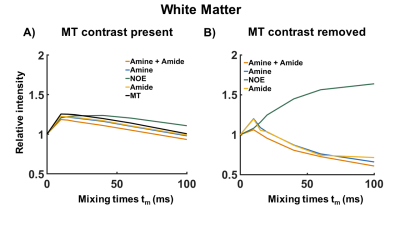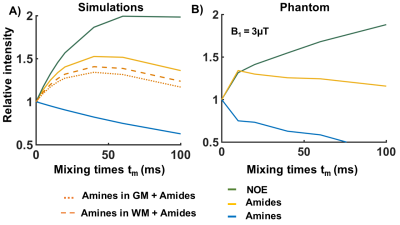Bárbara Schmitz Abecassis1, Elena Vinogradov Vinogradov2,3, Jannie P. Wijnen4, Thijs van Harten1, Evita C. Wiegers4, Hans J.M. Hoogduin4, Matthias J.P. van Osch 1, and Ece Ercan1
1Department of Radiology, Leiden University Medical Center, Leiden, Netherlands, 2Department of Radiology, UT Southwestern Medical Center, Dallas, TX, United States, 3Advanced Imaging Research Center, UT Southwestern Medical Center, Dallas, TX, United States, 4Department of Radiology, University Medical Center Utrecht, Utrecht, Netherlands
1Department of Radiology, Leiden University Medical Center, Leiden, Netherlands, 2Department of Radiology, UT Southwestern Medical Center, Dallas, TX, United States, 3Advanced Imaging Research Center, UT Southwestern Medical Center, Dallas, TX, United States, 4Department of Radiology, University Medical Center Utrecht, Utrecht, Netherlands
Variable delay multi pulse (VDMP) CEST imaging at 7T allowed identifying slow and fast exchanging solute pools present in the human brain in vivo, by means of saturation build-up curves upon MTC removal and evaluation of optimal B1 amplitudes.

Figure 4. A typical example of the effect of MTC on the VDMP build-up curves from the human WM for B1 = 1.99µT. In A) the saturation build-up of the different CEST-pools is plotted together with the MT contrast. In B) the MTC has been removed and the trend of the VDMP build-up curves from the CEST-pools with different exchange rates can be distinguished.

Figure 2. Normalized VDMP saturation build-up curves for different mixing times. A) Simulated build-up curves for CEST-pools found in the human brain: according to the concentration of amines in the GM (dotted line) and WM (dashed line) B) Build-up curves from glutamate (amines in blue) and bovine serum albumin phantoms (amides in yellow and rNOE in green). Both simulation and phantom data show a gradual build-up for slow exchanging molecules (rNOE and amides) as opposed to a fast decay from fast exchanging amines.
